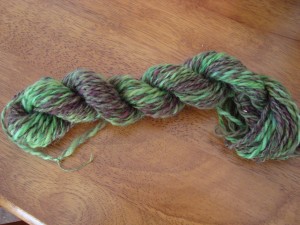Sat 4 Dec 2010
Remember the acid green yarn?
With some help from Branden, I finally finished getting it onto the loom last weekend, and wove a sample. I then cut the sample into three smaller samples, and have been playing with different ways of finishing the fabric.
On the left is the fabric as it comes off of the loom. It actually looks a bit thin, with distinct gaps between the individual threads. I was a little worried that I’d woven it too loosely, until I washed the second sample. The piece on the right is shown after simple washing. The wool bloomed beautifully, and makes a good, firm fabric. It also feels completely different; softer and more stable.
I saved one large section of the sample for “fulling” (the weaver’s version of felting). I’ve actually tried pretty hard to full it already, but have not succeeded yet. I transferred it back and forth between boiling and cold water 5 or 6 times, agitated by hand in warm water for about 15 minutes, and generally did all the things you’re not really supposed to do to wool. It hasn’t really changed much.
It’s always reassuring to actually try to felt something. It’s a lot harder than it seems, and it reminds me how overly careful I am with most of my woolen goods. (Except roving. You can never, ever be too careful with roving.)
The big sample is waiting for laundry time, when it will probably get tossed into the washer for a while to finish the felting process.
Unfortunately, I put this fabric on the big loom that I’m borrowing from a friend. I spent several weeks this summer cleaning the reed (the metal piece that all of the threads go through), but I apparently didn’t get enough of the rust off. I stripped it 3 times with vinegar, filed both sides of every single one of the 480 slats with an emery board, carefully brushed it out with a toothbrush, and then buffed between each of the slats with a piece of oiled yarn to get out the extra dust. And still, there is enough rust left to break my warp threads. I lost 6 threads just weaving the sample, and the yarn is thick enough to be difficult to repair, since any knots catch in the teeth of the reed. So, I think I will be moving this warp over to the smaller loom when its current project is finished, rather than trying to limp my way through on the rusty reed.
Despite the setback, I’m looking forward to finishing this project. The green yarn that was far too bright on its own really makes this fabric into something interesting, and I’m looking forward to getting it finished so that I can make things with it. Cutting up that sample confirmed for me that I really want to weave for sewing, rather than just working toward a project that comes off the loom already finished. Call me crazy, but I really like making a fabric that I can chop up and turn into other things.



That really is a pretty fabric. It’s too bad about the rusty reed; that must be so frustrating after all the work you put into cleaning it.
I’m intrigued by what you’ll do with your weaving. Mostly what I see from weavers are the rectangular finished-off-the-loom objects, so it will be fun to see what you come up with.
Really like the way it looks! The green looks really nice in it.
Sorry the loom isn’t working at as well as hoped.
Very cool. I love the colors in that fabric, and I can’t wait to see what it becomes! I agree with you about the felting; I also tend to feel that way about picking out ends I’ve woven in so I can frog – it’s so much harder than it seems like it should be, that I realize those ends aren’t going anywhere.
I love the idea of weaving for sewing. Your samples look wonderful for just that.
As for the rusty reed – why don’t you spin some warp out of steel wool? 🙂